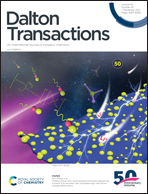γ-CuI from ionic liquid/poly(ionic liquid)s precursors with controllable morphologies and improved photocatalytic performance†
Abstract
γ-phase copper(I) iodide (abbreviated to CuI hereafter) with different morphologies is realized through a one-step redox process from I-containing ionic liquid (IL) or poly(ionic liquid)s (PILs) precursors at room temperature. The phase composition, morphology, and electronic states of the synthesized CuI samples are characterized by X-ray diffraction (XRD), scanning electron microscopy (SEM), and X-ray photoelectron spectroscopy (XPS). The resulting CuI products exhibit three different types of morphologies, namely nanocrystals, with an average size of 0.8 ± 0.2 μm, nanoplates, with a thickness of 35.8 ± 0.9 nm, and nanoflowers, with petals with a thickness of 12.2 ± 0.8 nm. Moreover, the as-synthesized CuI samples exhibit gradually diminishing bandgaps and improved photocatalysis performance for the photodegradation of rhodamine B (RhB) under visible light irradiation as the thickness decreases. XPS measurements confirm that IL/PILs coupled to the CuI surface, resulting in a further charge transfer between Cu and I. These results conclusively prove that IL/PILs serve as both the reducing agents and assemble as orientation templates in the formation of the CuI nanostructures, and also successfully mediate the functional properties of the samples by changing the surface electronic structures.



 Please wait while we load your content...
Please wait while we load your content...